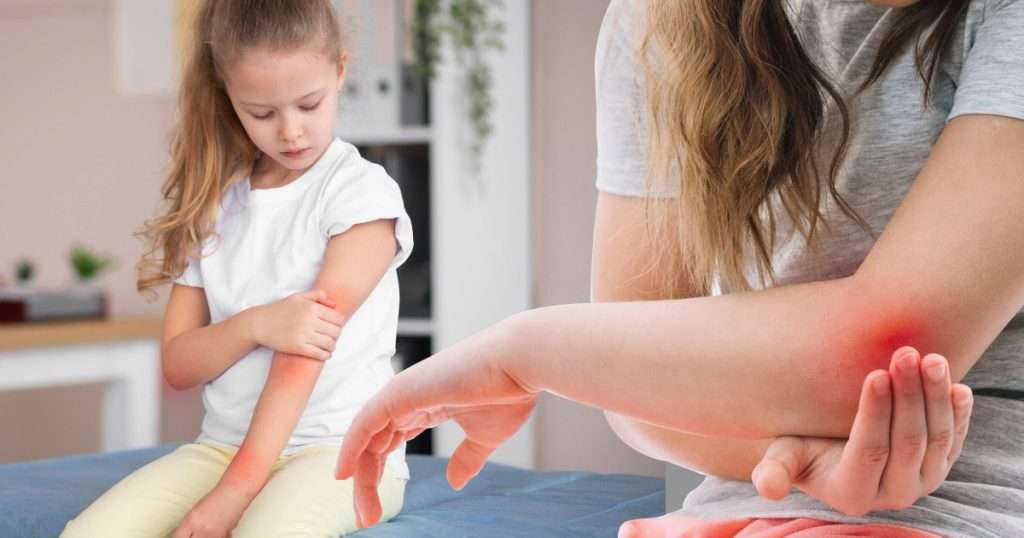Cellulitis, often characterized by its red, swollen appearance on the skin, is an infection that resides beneath the skin’s surface. While adults are more commonly affected, children, including infants and toddlers, are not exempt from this skin ailment. The question that arises is why cellulitis occurs in young individuals, and whether there are effective pediatric treatments available to alleviate their discomfort.
What is Cellulitis?
Cellulitis is an infection caused by bacteria that impacts the deeper layers of the skin and the tissue beneath. Common manifestations include the presence of redness, warmth, swelling, and discomfort within the afflicted region. While it is commonly associated with adults, it can also occur in children, including infants and toddlers.
Why Would Kids and Infants Get Cellulitis?
Cellulitis, typically seen as a condition affecting adults, can indeed find its way to the delicate skin of children and even infants. The factors contributing to this phenomenon are varied and encompass both physiological and environmental elements. One of the primary pathways through which children and infants develop cellulitis is via broken skin. Kids are known for their active lifestyles, which can lead to minor injuries such as cuts, scrapes, insect bites, and burns. These seemingly innocuous wounds create openings in the skin’s protective barrier, providing an entry point for bacteria to infiltrate and cause infection.
The tender and developing nature of children’s skin plays a role in their susceptibility to cellulitis. Their skin is thinner and more fragile than that of adults, making it easier for bacteria to breach the surface. Additionally, children’s immune systems are still in the process of maturation. This developmental phase renders them more vulnerable to infections like cellulitis. Their immune responses might not be as robust as those of adults, making it easier for bacterial invaders to establish themselves beneath the skin.
What are the Symptoms of Cellulitis in Kids?
Recognizing cellulitis symptoms in kids is crucial for getting timely treatment. While symptoms can differ from child to child, there are some common signs to watch for. The affected area is usually red, warm, and swollen, and the pain often gets worse as the infection spreads. One key sign of cellulitis is how quickly these symptoms can worsen, which sets it apart from other skin issues.
Parents should also be on the lookout for other signs, like fever, which can indicate a more serious infection that needs medical attention. Swollen lymph nodes near the infection site may also be present, showing the body is fighting off the infection. The combination of redness, swelling, pain, and fever can be both uncomfortable for children and worrisome for parents.
How to Treat Cellulitis in Children
When it comes to pediatric cellulitis treatment, a well-rounded approach is essential. The cornerstone of treatment for this condition is antibiotics, which work to eliminate the bacterial infection causing cellulitis. In mild cases, oral antibiotics are often sufficient. Medical practitioners have the option to recommend antibiotics like clindamycin, cephalexin, dicloxacillin, amoxicillin, or penicillin. These medications aim to target the specific bacteria responsible for the infection.
In cases where the presence of Staphylococcus aureus, including the potentially resistant MRSA strain, is suspected, a modified treatment approach might be recommended. Antibiotics like trimethoprim-sulfamethoxazole, doxycycline, or clindamycin may be considered to effectively combat the infection. It’s crucial to emphasize that the management of antibiotics must be supervised by a healthcare expert. Following the prescribed dosage meticulously and completing the entire course of antibiotics is essential to guarantee the comprehensive elimination of the infection and to avert its return.
How to Prevent Kids and Infants from Getting Cellulitis?
Preventing cellulitis in kids means taking steps to lower the chances of skin injuries that could lead to infection. Parents and caregivers play a big role in keeping their kids’ skin healthy. Encouraging them to wear protective gear during sports or outdoor play can help prevent minor cuts and scrapes.
Good hygiene is also key. Make sure to clean any cuts or scrapes with soap and water to reduce the risk of infection. Using antibiotic ointment and covering wounds with clean bandages adds extra protection. Also, remind kids not to pick at scabs or scratch irritated skin to avoid letting bacteria in.
Is There Pediatric Treatment for Cellulitis in Children?
The good news is that there are effective treatments for pediatric cellulitis, even in infants. The most common approach is antibiotics to fight the bacterial infection. For mild cases, oral antibiotics usually do the trick, with common options being clindamycin, cephalexin, dicloxacillin, amoxicillin, or penicillin.
If there’s a chance the infection is caused by Staphylococcus aureus, including the resistant MRSA strain, different antibiotics like trimethoprim-sulfamethoxazole, doxycycline, or clindamycin might be needed. It’s super important that treatment is guided by a healthcare professional, and that parents follow the full course of antibiotics to make sure the infection is fully cleared.
Parents should keep an eye out for skin changes in their kids—especially redness, warmth, swelling, or pain. If these are paired with a fever or signs of discomfort, it’s essential to see a doctor right away. More serious symptoms like extreme tiredness, confusion, low blood pressure, or a high white blood cell count mean immediate medical attention is needed.
Bottom Line
Cellulitis is a skin condition that can affect children, even infants and toddlers, causing discomfort and concern for parents and caregivers. The key to addressing pediatric cellulitis lies in early diagnosis and appropriate treatment. Parents and caregivers should be vigilant about any skin changes in their children, especially those accompanied by redness, warmth, swelling, and pain. Consulting a healthcare professional for accurate diagnosis and treatment recommendations is crucial. While cellulitis can be distressing, the availability of pediatric treatment options offers hope and relief for young patients.

